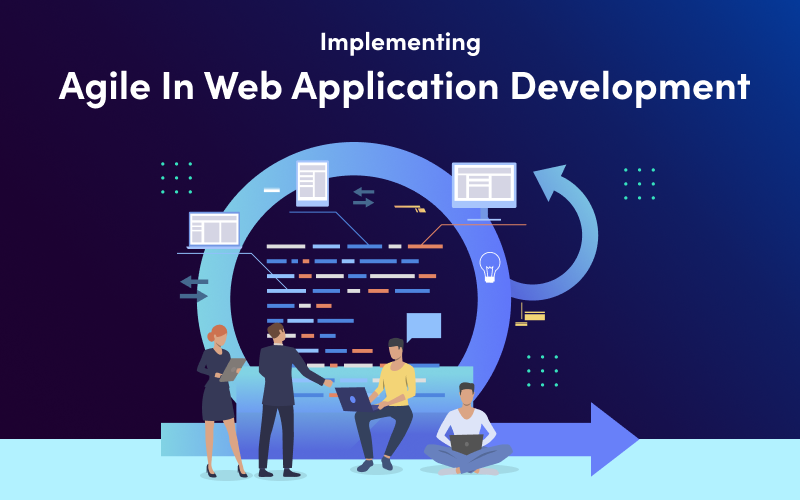How Web Application Development Agencies Implement Agile Methodology

Today, agility isn’t just a buzzword. It helps handhold a web application development project and takes it to completion. You must have seen web apps loading in a blink. Ask web application development agencies how it happens. The unanimous answer will be Agile–swift, user-centric, and constantly evolving.
Why Agile? Because adaptability is the key to success, especially since user preferences shift in the blink of an eye. Every line of code written and integrated design element is a step towards proactively anticipating user needs. The goal is not just to build web apps for today but to optimize them for future innovations and demands.
So, let us explore why we use agile methodology in software development. This blog is tailored for those who integrate agility as a web application development service. There is no jargon involved. This blog will guide you so you can leverage the Agile methodology to create web applications that stand out.
The Agility Roadmap: As Perceived By Web Application Development Agencies
Starting a project is akin to charting a course through unknown waters. You must implement the agile methodology throughout the entire software development lifecycle to gain visibility in this chaos. Create an itinerary to initiate the project. Follow the following steps.
Understand client and project requirements
Identify initial project requirements, prioritize them, and plan your resources accordingly. Formulate a team. Gather everyone required to execute the project, from developers to designers and even clients. Use their input to define the destination and the process of successfully navigating towards it. Understand what the app is supposed to do and calculate a realistic estimate for the entire project.
Sprint planning from Concept to Code
Break down the process into sprints. Span out your goals realistically. Remember that a sprint is a time period set to complete a task so that it is ready for review. Most web application development agencies strategically plan their sprints. Shorter sprints result in flexible and frequent working versions. With client feedback readily available with greater frequency, you can debug and fix errors efficiently. Longer sprints result in a more thorough and efficient output. So create your sprints carefully. Leverage the project scope for the same.
At the end of each sprint, share the progress with your stakeholders. Gather their feedback and change the course of your web application development accordingly. Then retrospect. Reflect on what went well. What made this sprint successful? What did not go well? Implement these insights in your next sprint to make it smooth and seamless.
Feedback Loops form the core of Agile projects
Keep the project progress consistent by gathering feedback from all involved stakeholders. Remember, each feedback is a clue. Decoding it will make you a much better agile web application development firm. Integrating feedback is not a compromise; it is a smart way to identify and solve problems, one sprint at a time. The result is a tangible, evolving web application.
Collaboration and feedback drive the continuous loop of planning, executing, and improving. The simplicity of the agile software development life cycle helps deliver outstanding digital products.
Product designing in Agile
Now that the entire Agile web application development project is in sprints, you can initiate the website app design and development. Allocate specific tasks to respective web app developers. Utilize the Agile board to keep track of these tasks. At the beginning, you will find many tasks lined up in the “To Do” list. But as we begin and complete sprints, these tasks move to the “In Progress” list. After you develop part of the website, you can start with the testing phase in agile web development.
This entire process of dividing the development into sprints helps speed up web application development. But to optimize the agile methodology and gain the best results, you must do everything in its designated manner. This will impart expertise, help you gather domain knowledge, ensure continuous delivery, and generate faster feedback. This is why a web apps development company can produce better output by adopting the agile methodology.
Testing to check sprint viability and success
Testing and gathering feedback run parallelly. As the client gives rapid feedback, tests are simultaneously conducted. This helps you to demonstrate the results immediately to the client and obtain feedback. Hence, both processes are independent but complementary. They further contribute to the success of web app development.
Most web application development agencies follow these simple steps to elevate web application quality. They achieve their goal without compromising on the speed of the app development process.
Communication and collaboration in Agile: a short note
Each Agile Web App development team member brings a unique skill set. This can be coding, designing, or testing. But silos do not exist in agile methodology. Hence, teams collaborate, tackle challenges, stay in sync with the latest developments, and celebrate wins collectively.
Distance is just a word in the current digital realm. Here, geographical limitations play no role. You can facilitate seamless collaboration between two agencies involved in the same project by adopting relevant tools and platforms. They help bridge gaps in virtual distances by tracking individual and team progress, establishing chat groups, etc. Hence, no one, no matter where they stay, is ever alone. Help is always at hand through the communication channels forming the core of Agile Methodology.
Client Inclusion and Agile
External stakeholder inclusion forms the core of every Agile web application development agency. Here, clients are more than spectators. They are actual contributors who keep offering feedback for every sprint completed. Leverage this to improve both the current sprint completed and eliminate these errors from recurring in the next.
Further, when you develop a web application for a client, it is important to sync it with their needs and requirements. Including the client in the agile web app development process will help you achieve this. As a result, you eliminate the need to make extensive changes after you develop the web application.
Further, when you involve the client in real-time, they know what is happening with their project. This also helps improve your relationship with the client. So make your client’s voice a cornerstone of your agile web app development. It is counterproductive and both you and the client benefit from this association.
Challenges That Agile Web Application Development Agencies Generally Face
Challenges drive innovation. Hence, they help improve the quality of a developed application. But if you do not tackle them on time, they can become immense roadblocks in your web app development process. So, anticipate your challenges and take measures to overcome them before they crop up. Here are some strategies that will help you with the same.
Tackle challenges head-on
Convert challenges into opportunities. Dive in, understand the issue, brainstorm solutions, and adapt. Remember to maintain focus. It will help ensure success.
Stay flexible and adapt to change easily
Technology is ever-evolving, and the agile methodology is no exception. New features and components keep popping up, and your project might see new requirements surface every other day. To keep up you must be flexible and adaptable. Welcome change by reshuffling your priorities and rescheduling and restrategizing plans. But never shift focus on your goal. The aim is to ensure relevance and longevity by delivering a product that meets current and future needs.
Common Agile Web App Development Challenges
Here are some common challenges that a web application development firm might face when adopting the agile methodology. We will also mention some probable solutions.
Scope creep
Sometimes, developers add new features that were absent in the original plan. There might be different reasons for this, like changing client needs, poor communication, unclear specifications, etc. But ultimately, this results in delays, cost enhancements, and poor-quality output.
Prevent scope creep by defining and prioritizing your MVP or Minimum Viable Product. Involve all external stakeholders in the planning and review process. Obtain regular feedback. Keep a backlog of the changes done and requests made during the web app development cycle. Also, set clear and realistic expectations regarding the scope and timeline of the project.
Technical debt
When you cut corners to meet deadlines or requirements, sometimes this can lead to incomplete or suboptimal code accumulation. This is known as technical debt. It can create obstacles in agile web app development. For example, you might struggle to manage, test, and extend your codes. Further, this might also introduce bugs and errors into the system.
Eliminate this challenge by proactively following all coding standards and conventions. Follow SOLID principles to write clean and modular codes. Perform code reviews and refactor your codes regularly. These practices will improve code quality and prevent you from writing unnecessary and obsolete codes.
Team collaboration
The agile methodology thrives on team collaboration. However, you might find it difficult to manage team members with different job titles and diverse skill sets and expectations. Further, if you are one of those web application development agencies that supports remote work, collaboration might become an issue. Working remotely from different time zones will further compound the issue.
Overcome this by introducing certain best practices for team collaboration—leverage available agile tools like Kanban and Scrum. Tools like Slack, Zoom, etc., also help improve team collaboration and communication. Further, establish team member roles and responsibilities clearly. Build trust among team members by fostering an environment of mutual respect, learning, and improvement.
Continuous learning
Acquiring and applying new skills and knowledge is an integral part of agile web app development. Keeping up with evolving industry trends, technologies, and best practices will improve team productivity and web app performance. However, a lack of time, resources, and motivation might limit the implementation of continuous learning.
Develop an internal system of feedback and support. Share these findings with your agile team members. Help them choose the right topics, sources, and methods. Set SMART learning and development goals. Evaluate their learning outcomes and see how they apply them to their work. Identify their strengths and laud them. Help them overcome their weaknesses.
User Feedback
This core strength of the agile methodology might sometimes become its nemesis. User feedback helps measure your app performance, validate your assumptions, and generally improve your product. But, collecting and analyzing user feedback can be challenging for a web application development agency. Sometimes, the feedback provided also tends to be vague and biased. Hence, you face difficulties in implementing them in your codes.
To leverage user feedback efficiently, define and segment your target audience. Try to obtain appropriate qualitative and quantitative data. Use relevant tools like heapmaps, usability testing, A/B testing, etc. Create feedback loops and iterations to improve feedback quality.
Conclusion
Agile is a mindset. It is the way forward for web application development agencies to create impactful web applications. You must implement the agile methodology in your web app development. It will help you embrace change, foster collaboration, value and implement feedback, etc. The journey of building a web app together is exciting. Every sprint you develop, each piece of feedback you gather, and every time you retrospect, you inch closer to attaining excellence. Hence, leverage the agile methodology and craft web applications capable of seamlessly navigating the dynamic and ever-evolving digital landscape.











